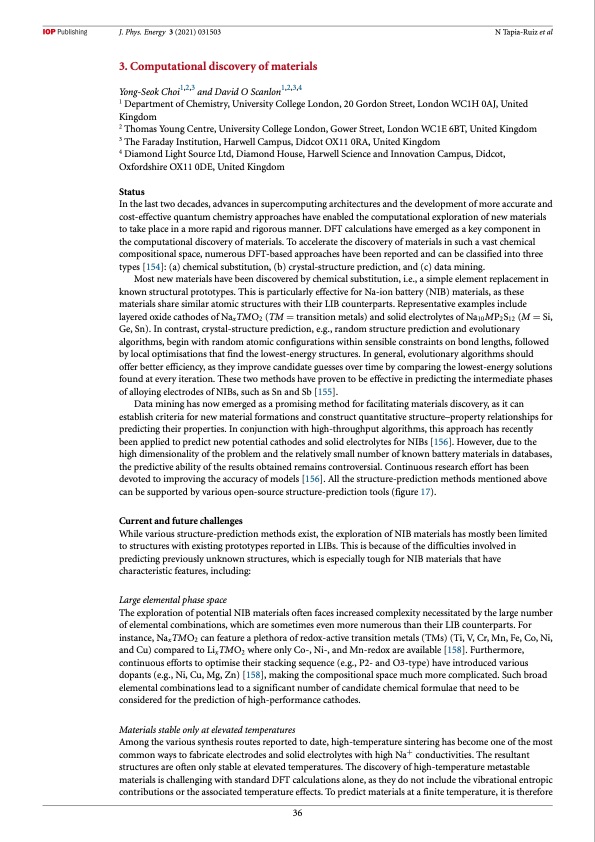
PDF Publication Title:
Text from PDF Page: 037
J. Phys. Energy 3 (2021) 031503 N Tapia-Ruiz et al 3. Computational discovery of materials Yong-Seok Choi1,2,3 and David O Scanlon1,2,3,4 1 Department of Chemistry, University College London, 20 Gordon Street, London WC1H 0AJ, United Kingdom 2 Thomas Young Centre, University College London, Gower Street, London WC1E 6BT, United Kingdom 3 The Faraday Institution, Harwell Campus, Didcot OX11 0RA, United Kingdom 4 Diamond Light Source Ltd, Diamond House, Harwell Science and Innovation Campus, Didcot, Oxfordshire OX11 0DE, United Kingdom Status In the last two decades, advances in supercomputing architectures and the development of more accurate and cost-effective quantum chemistry approaches have enabled the computational exploration of new materials to take place in a more rapid and rigorous manner. DFT calculations have emerged as a key component in the computational discovery of materials. To accelerate the discovery of materials in such a vast chemical compositional space, numerous DFT-based approaches have been reported and can be classified into three types [154]: (a) chemical substitution, (b) crystal-structure prediction, and (c) data mining. Most new materials have been discovered by chemical substitution, i.e., a simple element replacement in known structural prototypes. This is particularly effective for Na-ion battery (NIB) materials, as these materials share similar atomic structures with their LIB counterparts. Representative examples include layered oxide cathodes of NaxTMO2 (TM = transition metals) and solid electrolytes of Na10MP2S12 (M = Si, Ge, Sn). In contrast, crystal-structure prediction, e.g., random structure prediction and evolutionary algorithms, begin with random atomic configurations within sensible constraints on bond lengths, followed by local optimisations that find the lowest-energy structures. In general, evolutionary algorithms should offer better efficiency, as they improve candidate guesses over time by comparing the lowest-energy solutions found at every iteration. These two methods have proven to be effective in predicting the intermediate phases of alloying electrodes of NIBs, such as Sn and Sb [155]. Data mining has now emerged as a promising method for facilitating materials discovery, as it can establish criteria for new material formations and construct quantitative structure–property relationships for predicting their properties. In conjunction with high-throughput algorithms, this approach has recently been applied to predict new potential cathodes and solid electrolytes for NIBs [156]. However, due to the high dimensionality of the problem and the relatively small number of known battery materials in databases, the predictive ability of the results obtained remains controversial. Continuous research effort has been devoted to improving the accuracy of models [156]. All the structure-prediction methods mentioned above can be supported by various open-source structure-prediction tools (figure 17). Current and future challenges While various structure-prediction methods exist, the exploration of NIB materials has mostly been limited to structures with existing prototypes reported in LIBs. This is because of the difficulties involved in predicting previously unknown structures, which is especially tough for NIB materials that have characteristic features, including: Large elemental phase space The exploration of potential NIB materials often faces increased complexity necessitated by the large number of elemental combinations, which are sometimes even more numerous than their LIB counterparts. For instance, NaxTMO2 can feature a plethora of redox-active transition metals (TMs) (Ti, V, Cr, Mn, Fe, Co, Ni, and Cu) compared to LixTMO2 where only Co-, Ni-, and Mn-redox are available [158]. Furthermore, continuous efforts to optimise their stacking sequence (e.g., P2- and O3-type) have introduced various dopants (e.g., Ni, Cu, Mg, Zn) [158], making the compositional space much more complicated. Such broad elemental combinations lead to a significant number of candidate chemical formulae that need to be considered for the prediction of high-performance cathodes. Materials stable only at elevated temperatures Among the various synthesis routes reported to date, high-temperature sintering has become one of the most common ways to fabricate electrodes and solid electrolytes with high Na+ conductivities. The resultant structures are often only stable at elevated temperatures. The discovery of high-temperature metastable materials is challenging with standard DFT calculations alone, as they do not include the vibrational entropic contributions or the associated temperature effects. To predict materials at a finite temperature, it is therefore 36PDF Image | 2021 roadmap for sodium-ion batteries

PDF Search Title:
2021 roadmap for sodium-ion batteriesOriginal File Name Searched:
roadmap-sodium-ion-batteries_031503.pdfDIY PDF Search: Google It | Yahoo | Bing
Salgenx Redox Flow Battery Technology: Salt water flow battery technology with low cost and great energy density that can be used for power storage and thermal storage. Let us de-risk your production using our license. Our aqueous flow battery is less cost than Tesla Megapack and available faster. Redox flow battery. No membrane needed like with Vanadium, or Bromine. Salgenx flow battery
| CONTACT TEL: 608-238-6001 Email: greg@salgenx.com | RSS | AMP |